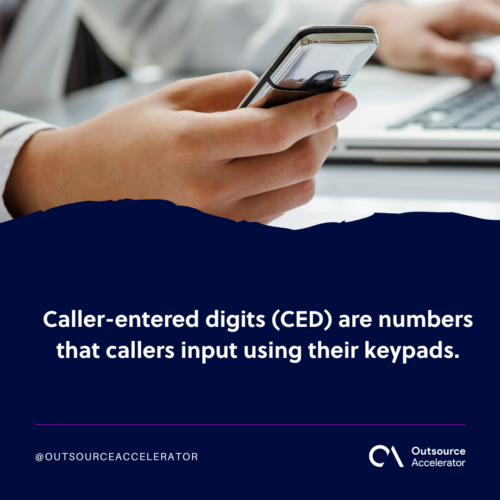Caller-entered digits
Definition
What are caller-entered digits?
When a customer calls a business, they might enter digits on the phone keypad to access specific menu options or to speak with someone in the company.
Caller-entered digits (CED) are numbers that callers input using their keypads. They are primarily used to navigate through an interactive voice response (IVR) system to get through an active agent or a self-service channel.

How do caller-entered digits work?
In an IVR system, an artificial voice will ask the caller to type in a number in order to advance through the menu. This is where the digits come into play. The prompts serve as a guide for the callers to listen to.
Callers may encounter errors if the system itself isn’t maintained. Furthermore, callers may be deterred from reaching out via a call if the system is too convoluted or complex. It’s important to keep in mind that IVRs should be straightforward and programmed right.
On the other hand, if the agent had an error with the digits, they could potentially send the caller to the wrong department. This, in turn, could anger the caller and affect the agent’s customer satisfaction rates.
If one were to run a business, it’s important to know what caller-entered digits are and how they can impact the operations. While this may seem like a minor detail, it can actually have a big impact on a company’s customer satisfaction rates and the bottom line.
Caller-entered digits and voice recognition via IVRs
When it comes to digitizing a customer service channel, there are two main ways that you can go about it: caller-entered digits or voice recognition.
Both systems have their own benefits and drawbacks, so which one is right to run a modern business?
While caller-entered digits have been tried and tested, voice recognition has been a close second when it comes to the modernization of a call center.
Drawbacks of voice recognition through IVRs:
- Accent recognition. Some voice recognition software has a hard time deciphering regional accents or people with thick accents.
- Speech accessibility. Businesses always need to recognize the needs of their users, along with developing accessible customer access channels. If speech recognition was the only way to contact a representative, then the company will have a hard time reaching a marginalized segment of their target audience.
- Multilanguage users. Underdeveloped voice recognition systems may not have other languages but English. If the company’s audience reach is worldwide, they might unintentionally leave out non-English speakers by having an English-only voice recognition system.
Although caller-entered digits and voice recognition via IVRs are still not perfect, they are getting better all the time.
With the continued refinement of these technologies, businesses can rely on them to provide a more personalized customer experience that is convenient and efficient.







 Independent
Independent




